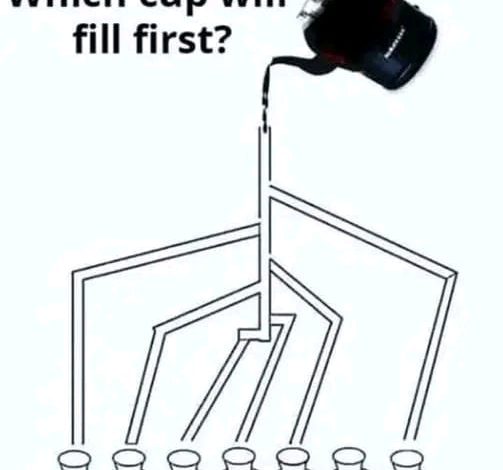Solving the Puzzle: Which Cup Fills First?

ADVERTISEMENT
Solving the Puzzle: Which Cup Fills First?
Introduction:
The puzzle presented in the image challenges the viewer to determine which of the numbered cups will fill first. This type of brain teaser is not just a fun exercise but also a practical test of one’s ability to analyze and predict fluid dynamics in a simplified system. It encourages critical thinking, attention to detail, and spatial awareness.
Discussion:
1. Analysis of the Puzzle Setup:
ADVERTISEMENT
- The image shows a series of cups labeled from 1 to 7 at the bottom, with a complex network of interconnected pipes leading to them from a single pouring point.
- To determine which cup fills first, one must trace the path from the pour point through the network, noting any blockages or splits that would affect the flow.
2. Potential Outcomes:
- Direct Paths and Blockages: Initially, it may seem logical to assume that the first cup in the sequential order of the pipes will fill first. However, if any paths are blocked or if the design diverts water to a different cup, the outcome changes.
- Cup Capacity and Path Length: Assuming all paths are open and cups have the same capacity, the shortest path would likely fill first. The complexity of this puzzle lies in observing that not all paths may be viable due to hidden blockages or design tricks.
3. Strategies for Solution:
- Visual Inspection: Carefully follow each path from the pouring point to each cup, checking for any interruptions or hidden diversions that might alter the expected flow.
- Logical Deduction: Use reasoning to eliminate cups that have longer or more complex paths, focusing on those directly aligned with the flow from the pour point.
Conclusion: This “Which Cup Fills First?” puzzle is more than just a trivial question; it’s a cognitive exercise that tests our perceptual and problem-solving skills. Such puzzles are used in educational contexts to enhance logical thinking and in professional settings to gauge technical understanding in fields related to fluid dynamics and engineering.
Whether for educational purposes, professional assessment, or just plain fun, puzzles like these play a significant role in developing various cognitive abilities. Next time you come across such a challenge, take a moment to appreciate the complex thinking skills you’re employing to find the solution!
ADVERTISEMENT




